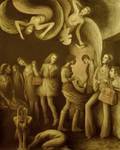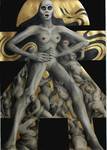Why do you create art? Why are you an artist?
When I was a child, Hilary Knight’s line drawings in the “Eloise” books inspired me to want to draw well. His work also made me see how drawing, beyond its intrinsic value, could be put to storytelling. After that, and after my fifth grade teacher taught our class to draw in two point perspective, I became a dedicated drawer at an early age.
Yet, having grown up in New York, I was equally obsessed with Broadway shows. As part of my college entry portfolio, I designed and illustrated pretend pieces for Lincoln Center. I studied Graphic Communications and Illustration and began my career in Entertainment Advertising. I think it was Push Pin Studio’s theatre poster and subscription promotions that had made the light bulb go off in my head about Graphic Design and Illustration. And more powerful than most “fine art” of that time, I saw that illustrators like Alan Cober and Sue Coe could convey social and political commentary.
Of course part of me wished I had studied painting in college, or had later gotten an MFA to transition more gracefully from applied to fine art. But after a lifetime of acquired knowledge and experience, from which I learned more about art in general, and during which I developed an interest in Renaissance culture, my ideas about the meaning and power of art are more all encompassing. I guess I’m an artist (and make the sort of art I do) because I love putting my cumulative interests, limitations, and skills, to good and complementary use.
Why have you picked specific subjects or themes?
Usually my work comments on contemporary American, Middle-Class female experience. It may not be the most profound, earth-shattering depiction of female experience, when you look around the world, but it’s what I know. I’ve probably been heading that way before I even started to make art. After college, I happened to read some very interesting books about women and art by people like Dorothy Dinnerstein and Lucy Lippard. I learned about the Gorilla Girls and why they had come into being, and I saw Judy Chicago’s “Dinner Party.”
By lucky happenstance I became one of the first docents at the National Museum of Women in the Arts. Above and beyond finding out about past women artists, I learned how to combine research and critical analysis to “read between the lines” in artwork to understand women’s history. Now I’m sort of working from the reverse of that, trying to put recognizable female-oriented themes in interesting, pleasing, dramatic, and occasionally amusing compositions. All in all, I feel I am working in a female artist continuum.
What mediums do you like and why?
I care more about content than about mediums, and am more concerned with how to play with iconic artworks and manipulate their meanings to my ends. For example in a recent piece, by high-jacking a Caravaggio altarpiece composition, I highlighted how Consumerism has become our religion.
To paint, I like acrylics because I generally work fast and actually prefer the fast-drying factor. Right now, drawing is my best tool. I’m working hard to reach the same articulateness in paint. I love graphite pencil because you can make strong, blunt strokes or soft, gradated smudges, or manipulate tone with a kneaded eraser. You can build up layers or create high contrast, and you can heighten the image with white or black tempera or limited color—especially red accents. It’s a high-contrast, graphic look, borne I guess of my graphic design work. Almost poster-like and hopefully as impactful.
Do you have any advice or tips for other artists?
Know how to exploit your chosen medium like an extension of your brain and hands, and to work midway between controlled and loose. Persist even if you’re a late bloomer like me. Age enriches and emboldens you, and you can be more adamant about what you want to say.
Know when to stop taking classes and being a student. Forge ahead in making your own art. But keep looking at lots of art to learn what’s good and bad and what works–but be true to yourself.
Understand what you have to do to get your stuff out there in front of people—and do it! The most profound advice I ever received was that the most crucial thing any artist needs is courage.
What do you love about art?
Art enables people to connect on personal and collective levels. The viewer connects with the artwork, the artist, and they can also connect with other people by discussing the art. Art can reveal beauty, ugliness, and truths about other people, cultures, and history. It’s a time travel portal and a filter for personal and collective human experience.
If you could visit any museum in any country, which would it be and why?
That’s impossible to answer! I want to see everything, everywhere!
Which of your artworks is your favorite?
My favorite piece is a line drawing I did about forty years ago of my grandfather and his wife. They’re themselves but they’re also characters in an invented story. I drew them as the proprietors of an old fashioned lunch counter, the kind you don’t see too much anymore. They have a rapport with the viewer and with each other. They do what I like all of my people subjects to do: they seem alive in their own little universe. And it’s a special way of keeping Poppy and Anna alive to me.
What would you like to leave us with as we view your art and read this interview?
I like making art because it’s a way to learn about the world, people, and yourself. It’s a means of communication to understand and connect. To me, it’s a way of finding meaning in life and making sense of the world. That’s why, between leaving design and becoming a fine artist, I put together art programs for schools and worked in children’s arts non-profits.
I don’t know what kind of art I’ll be making as time goes on, or with what medium. My goal is to progress my content and technique forward. I’m not sure yet what my terms of success are in terms of the “art market,” but I want to make art that makes people look and think. I became a “real” artist only in my fifties. It’s apparent my work retains aspects of graphics and Illustration. But I feel gratified when people enjoy my “Representational Statement Art” and get what I’m saying.




